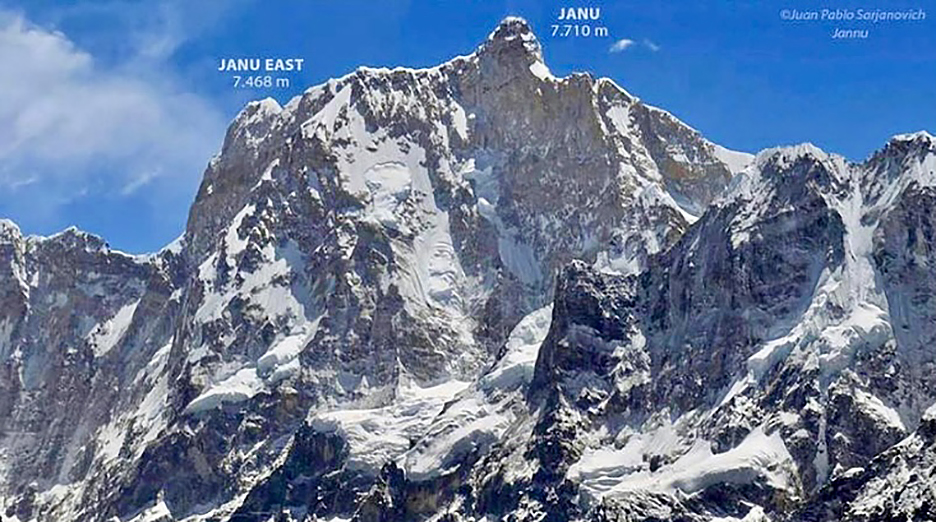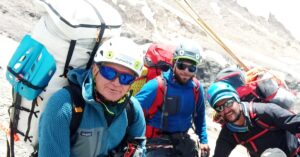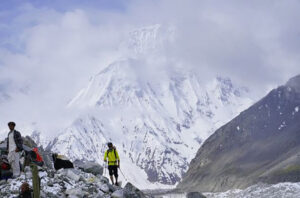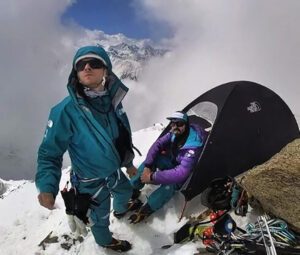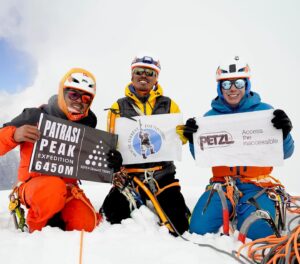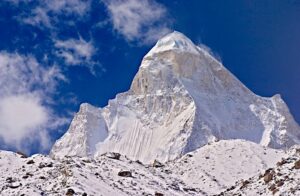Every spring for over a century, the American Alpine Club announces the American expeditions they will support with a Cutting Edge Grant. The grant supports pure alpine-style projects to difficult, remote mountains.
This year, we will see action on five peaks: Shivling, Yashkuk Sar, Jannu East, Ultar Sar, and Chiling II. This series looks at the climbing history of each peak. We have already written about Shivling and Yashkuk Sar. Today, we continue with unclimbed Jannu East.
Jannu (also known as Khumbhakarna or Phoktanglungma) stands in eastern Nepal, 9.5km west of 8,586m Kangchenjunga, on the Indian border.
The Jannu Glacier runs along the whole north side of the mountain. On the south and east sides, the Yalung Glacier, the main approach route to Kangchenjunga, drains the massif. On the western side, the Yamatari Glacier penetrates deep into the heart of the mountain.

Jannu and Kangchenjunga from a plane. Photo: Oleg Bartunov
Each route extremely difficult
Jannu’s main peak is 7,711m while Jannu East measures 7,468m. All the colossal massif’s established climbing routes — and future ones — are extremely difficult. Jannu East remains unclimbed and is one of the most coveted prizes left in Nepal.
There is often some confusion regarding the east face (of Jannu) versus the east summit (Jannu East). The east face of Jannu remains unclimbed to the summit, although Russians Dmitry Golovchenko and Sergey Nilov opened the face itself in 2019. The pair climbed the east face to the south ridge at 7,412m before retreating.
Meanwhile, Jannu East has rebuffed several attempts and remains unclimbed by any route.
Early attempts
In the autumn of 1957, Guido Magnone led a reconnaissance expedition to Jannu. Magnone’s team included fellow Frenchmen Jean Bouvier and Pierre Leroux, and five sherpas led by Gyalzen Sherpa.
“We have now seen all the faces of Jannu and have examined all its ridges,” Magnone wrote in his report for the Himalayan Club. “It…seems to present a continuous series of difficulties from its base to its summit.”
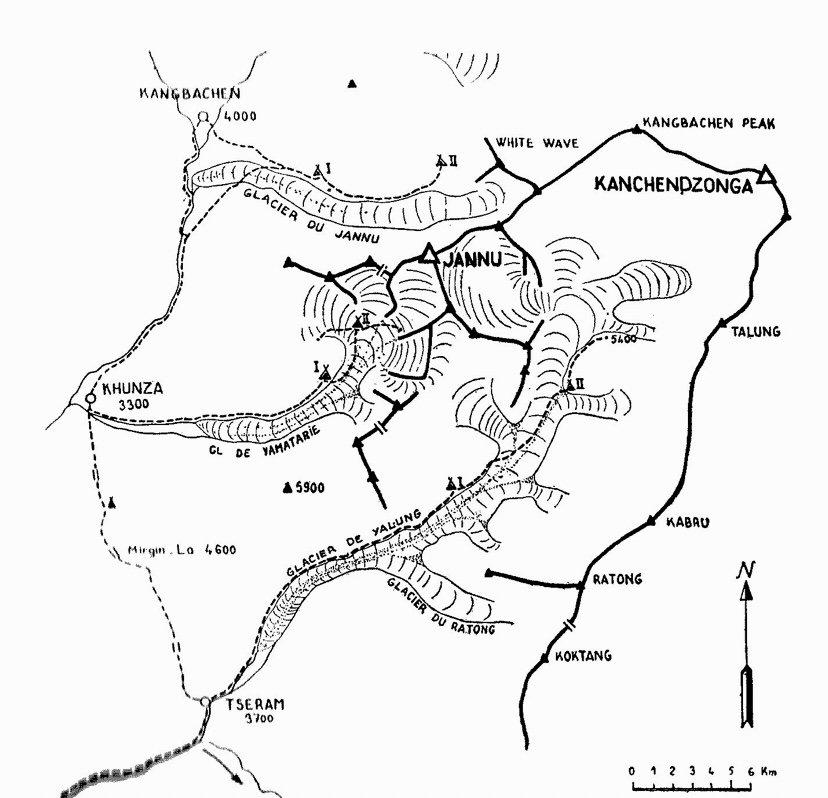
The main approaches to Jannu. Photo: Guido Magnone for the Himalayan Club
In the spring of 1959, Jean Franco led a 12-member party to Jannu. The French team included Jean Bouvier, Rene Desmaison, Philippe Dreux, Jean-Michel Freulon, James Lartizien, Maurice Lenoir, Pierre Leroux, Guido Magnone, Robert Paragot, Lionel Terray, and Wangdi Sherpa. They attempted to climb Jannu by the south ridge using supplementary oxygen. The team eventually gave up at 7,400m because of dangerous route conditions.
The first ascent of Jannu
Finally, on the third try, the French achieved their goal. In the spring of 1962, Lionel Terray led a party back to Jannu’s main peak. The team included Andre Bertrand, Jean Bouvier, Guy De Haynin, Rene Desmaison, Paul Keller, Maurice Lenoir, Pierre Leroux, Robert Paragot, Yves Pollet-Villard, Jean Ravier, Rene Vernadet, Gyalzen Sherpa, and Wangdi Sherpa.
They climbed no-O2 via the south ridge. On April 27, Desmaison, Keller, Paragot, and Gyalzen topped out. The next day Bertrand, Bouvier, Leroux, Pollet-Villard, Ravier, Wangdi Sherpa, and Terray summited.

The southwest face of Jannu from the Yamatari Glacier in 1957. The summit is in the clouds on the left skyline. Photo: Guido Magnone/Himalayan Club
Seventy-seven people have summited Jannu Main, all without bottled oxygen — a beautiful homage to an incredible mountain.
Jannu was last ascended in the autumn of 2023 by Americans Matt Cornell, Jackson Marvell, and Alan Rousseau. The team summited after carrying out the first alpine-style ascent of the north face of Jannu. Meanwhile, two other American climbers, Sam Hennessey and Michael Gardner, attempted the north face of Jannu East.
Five mountaineers have lost their lives on Jannu, three of them without reaching the summit and two during the descent.
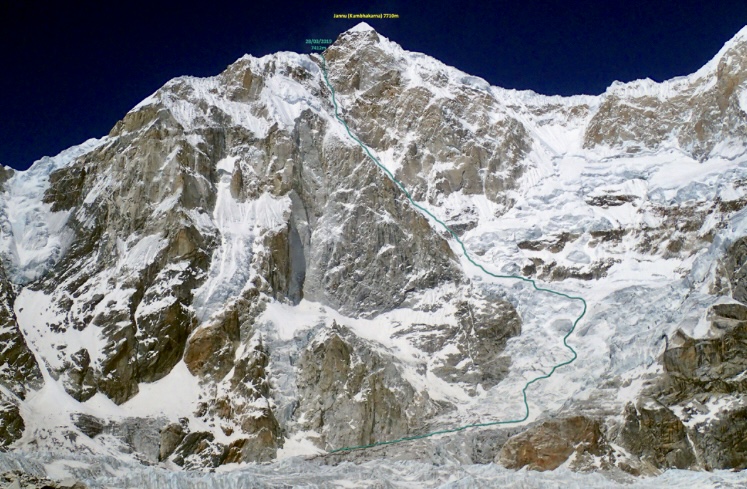
The Russian route ‘Unfinished Symphony’ on the east face of Jannu Main in 2019. The climbers descended the French route, behind the ridge to the left. Photo: Dmitry Golovchenko
Attempts on Jannu East
There have been 12 attempts to summit 7,468m Jannu East, mostly by Slovenian climbers.
In the spring of 1991, Tone Skarja, Vanja Furlan, and Bojan Pockar attempted to climb the eastern summit of the Jannu massif by its east face. They abandoned their climb at 7,050m in bad weather, with frostnip and other problems.
In the spring of 1992, Furlan and Pockar returned. This time, they climbed with Matjaz Vrtovec. The three Slovenians eventually retreated from 7,100m, utterly exhausted. In bad weather, the party had run out of food and gas.
“This face is technically very difficult in its entirety. It’s only possible if you have enough energy. The problem is altitude, good preparation, and the need to descend the same way,” the team told The Himalayan Database.
In the autumn of 1992, another Slovenian group arrived. Dusan Debelak, Danijel Badrac, Anton Pavlic, Rudi Podgorsek, Damjan Vidmar, and Tomaz Zerovnik planned to climb Jannu East, again by its east face.
But during the approach march, tragedy struck. On a hot day, Vidmar went for a swim in the monsoon-swollen Kabela Khola River and disappeared. The expedition was immediately abandoned.
One year later, in the autumn of 1993, Dusan Debelak returned with August Robnik and Tomaz Zerovnik. The trio aborted at 6,800m because of avalanches on dangerous terrain.
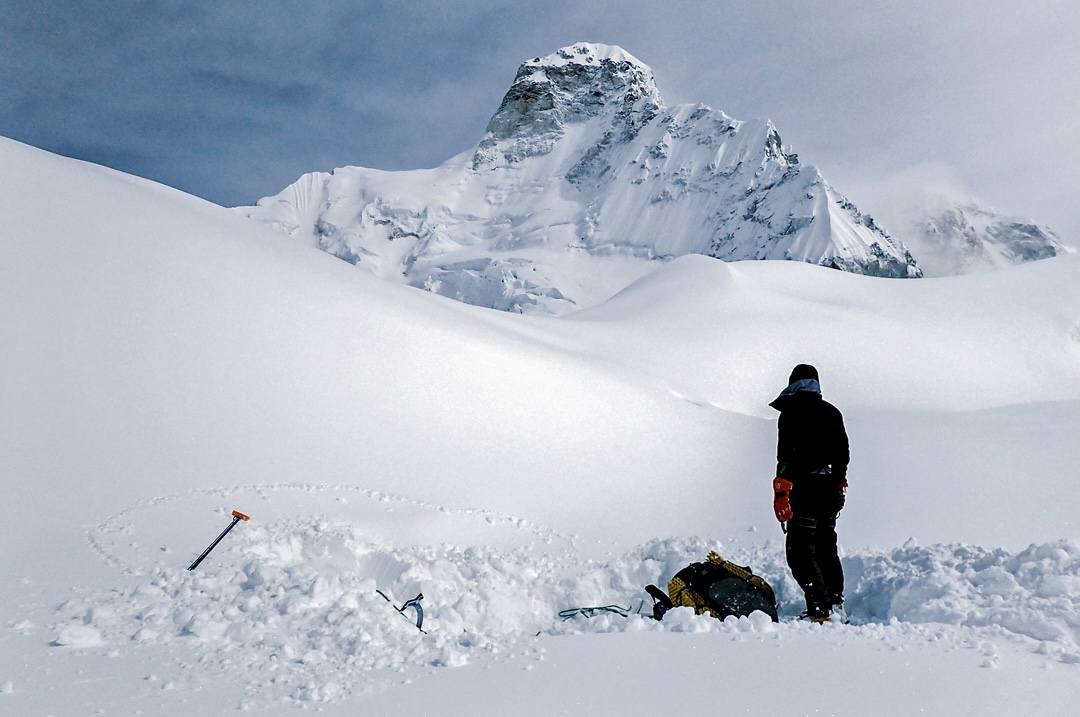
Dmitry Golovchenko looks back at the summit of Jannu and the upper part of the French Route from the Throne Glacial Plateau. Photo: Sergey Nilov
Tragedy strikes
In the autumn of 1996, Bojan Pockar and Ziga Petric wanted to climb the east face of Jannu East in alpine style. Anda Perdan accompanied them to base camp.
On September 30, before the start of their ascent, Pockar and Petric went to acclimatize on Kabru. On the second day of their acclimatization, the weather suddenly changed. Clouds rolled in, and it started to snow. The climbers were unroped at about 6,000m.
By Oct. 6, they had not returned to base camp, and there was no sign of them. Initially, there was some hope that Pockar and Petric had descended the Sikkim side of the mountain, but they did not appear. Perhaps the duo suffered a fall or were smothered by snow in their small tent.
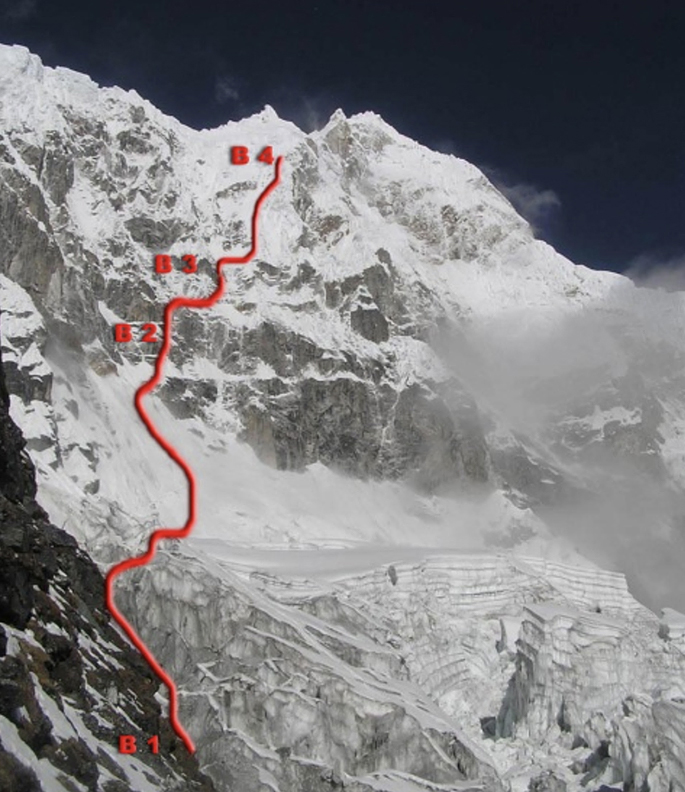
Tomaz Humar’s attempt on Jannu East in 2004. Photo: Tomaz Humar
More attempts turned back
There were three further Slovenian attempts on Jannu East, all via the east face.
In the spring of 1998, a team led by Franc Gajsek gave up at 5,080m because of bad weather and constant avalanches.
In the spring of 2002, Gregor Lacen’s team retreated from 5,400m. Once again, bad weather was to blame.
In the autumn of 2004, Tomaz Humar stopped at 7,000m when faced with impassible overhanging mushrooms. Humar described the climb as an up-and-down nightmare while trying to avoid snow and ice mushrooms and avalanches.
Two more expeditions tried Jannu East. In 2019, Michael Gardner, Sam Hennessey, and Robert Craig tried via the east face, but there are no details on their climb in The Himalayan Database. In the autumn of 2022, a Spanish party led by Mikel Zabalza also tried the east face without success.
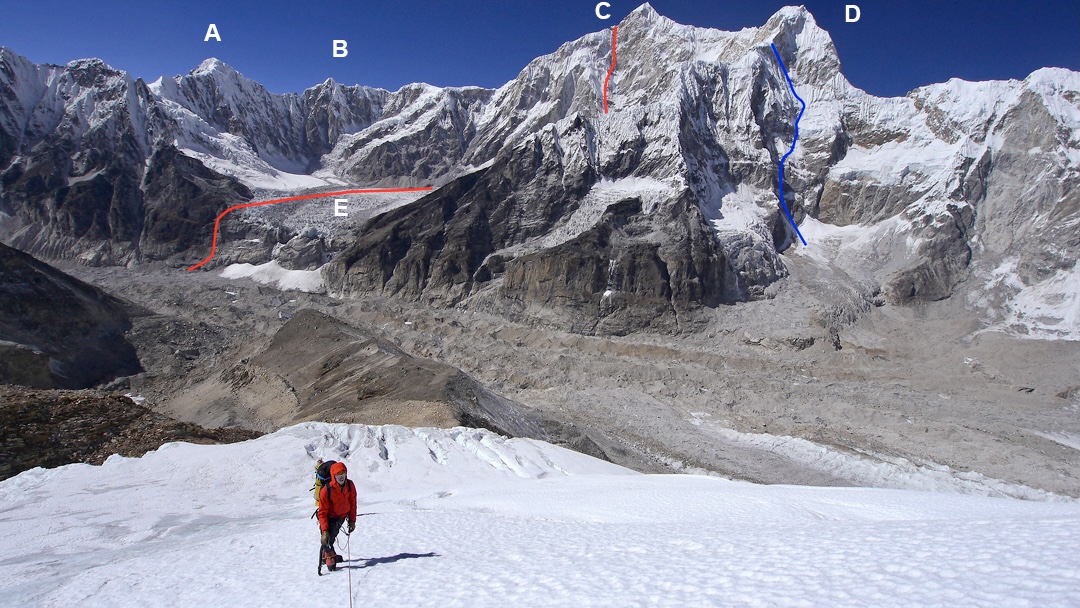
Looking west from the lower slopes of Talung. A. Tso Kang North (6,309m). B. Tete du Butoir (ca. 6,500m). C. 7,711m Jannu with the line of the Russian route, Unfinished Symphony, including the initial rock buttress above the Talung Glacier. E. Jannu plateau of Jannu Southeast Glacier. D. 7,468m Jannu East, showing the best attempt to date on its east face, reaching 7,100m (Furlan, Pockar, 1992). Photo: Gavin Pike via The American Alpine Journal
Attempts on the north face of Jannu East
After the eight unsuccessful Slovenian attempts on the east face, the Italian pair David Bacci and Luca Moroni attempted the north face in the autumn of 2018. This was the first attempt not to use the east face of Jannu East.
However, the climb was abandoned on Oct. 5, only two weeks after they arrived at base camp. Moroni decided the attempt was too risky. He did not feel acclimatized enough to attempt such a hard wall.
“Once up there, I thought the east ridge to Jannu East from the north face might be a good solution for an alpine-style team,” Bacci said after the expedition.
In the autumn of 2023, Michael Gardner and Sam Hennessey reached 7,010m on the north face before they stopped in high winds.

Sam Hennessey and Michael Gardner’s attempt on the north face of Jannu East in 2023. Photo: Sam Hennessey/Michael Gardner
Hennessey returns to Jannu East in 2024
Sam Hennessey received the Cutting Edge Grant and will return to Jannu East’s north face this year. He has not yet said whether he will climb again with Gardner or with different partners.
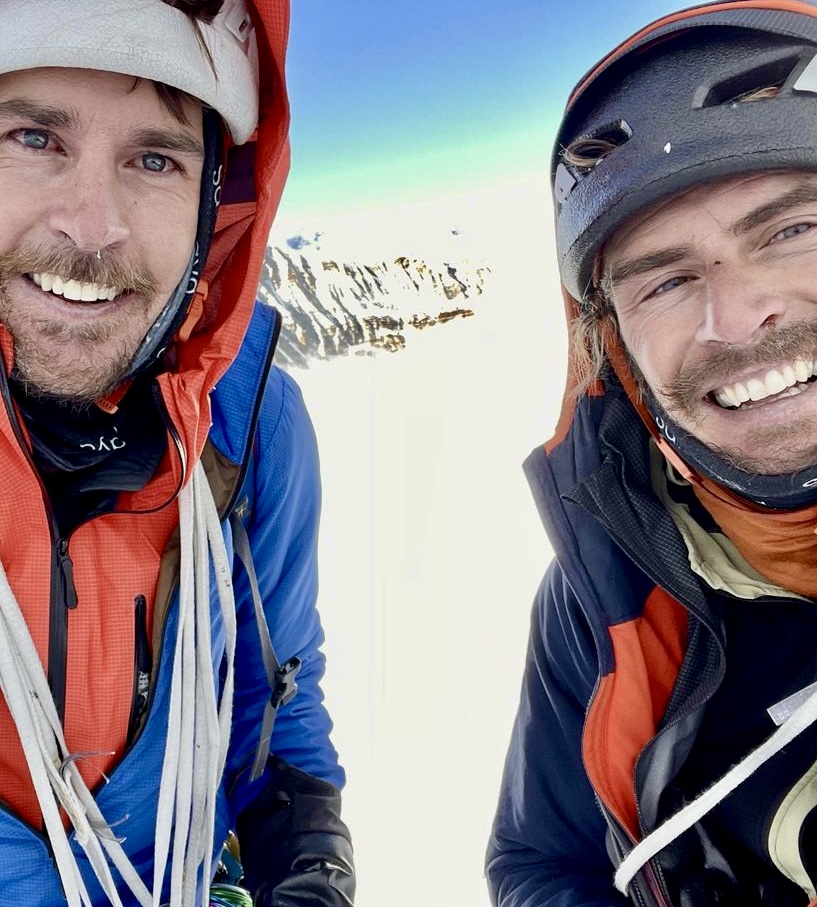
Michael Gardner and Sam Hennessey. Photo: Michael Gardner/Sam Hennessey
